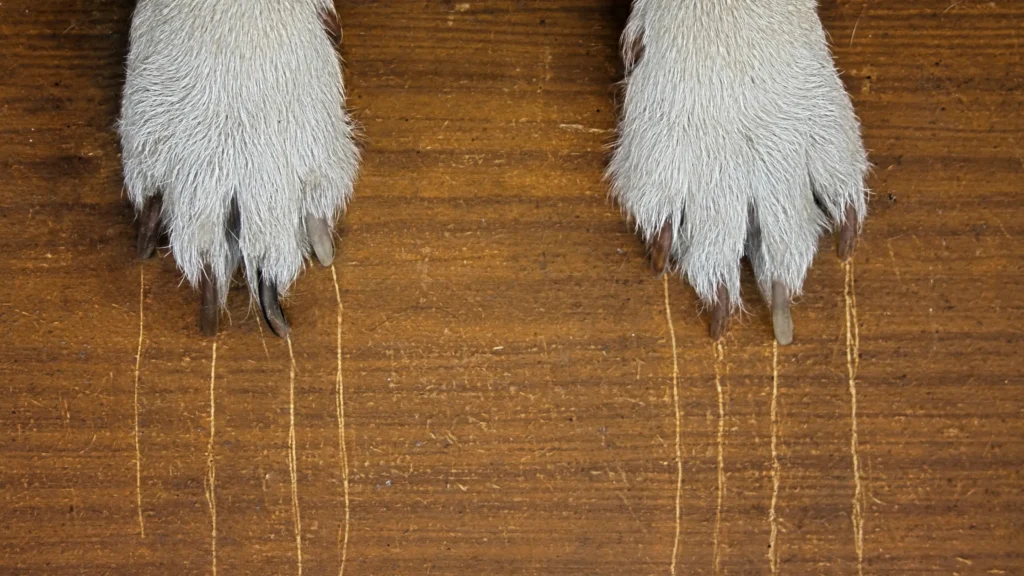Do you dread coming home to scratched-up doors and windowsills thanks to your anxious canine companion? As a dog owner, a scratched front door or bedroom door can be incredibly frustrating. But don’t worry – with some patience and targeted training, you can curb this undesirable behavior. In this comprehensive guide, we’ll explore the reasons, actionable solutions for how to stop a dog scratching at the door. Let’s get started!
Why Dogs Scratch Doors
Before jumping into training techniques, it’s important to understand the motivation behind the behavior. There are a few common reasons dogs scratch doors:
Separation Anxiety
Dogs are highly social pack animals that can develop separation anxiety when left alone. Scratching doors is a distress signal that translates to: “Let me back in with my people!” Other signs of separation anxiety include barking, whining, pacing, and destruction.
Boredom
An under-exercised dog with pent-up energy will often act out with undesirable behaviors like scratching. When dogs don’t receive adequate physical and mental stimulation, they resort to uncontrolled activities to entertain themselves.
Fear/Stress
Dogs may frantically scratch to escape perceived threats like loud noises from storms, construction, or rowdy kids. Identifying and managing what stresses your dog can curb scratching.
Attention-Seeking
Some dogs learn that obnoxious door scratching does the trick to get their owners to let them back inside. So this behavior gets reinforced over time. Now that we know why dogs scratch doors, let’s explore constructive solutions:
Tire Out Your Dog With More Exercise
Preventing door scratches starts with meeting your dog’s needs for activity. Simply put, a tired dog is less likely to destroy your home. Most dogs require 30-60 minutes of exercise daily, including high energy activities like running, playing fetch, or swimming. On days when you can’t exercise your dog adequately, consider hiring a dog walker on Wag!. Wag! walkers can give your dog much-needed outdoor time, bathroom breaks, and exercise. You’ll come home to a happier, calmer dog less inclined to act out.
Train Your Dog to Settle on Their Own
While vigorous exercise helps tire out your dog’s body, you must also train their mind. One of the best things you can teach dogs is how to chill out and settle on their own. This self-soothing behavior prevents problem scratching when you’re gone or occupied. Use treats to reinforce calm behaviors like lying down on a dog bed. Gradually work up to longer “settle” durations before rewarding your dog. You want to set the expectation that sometimes relaxing quietly is desired. Teaching basic obedience commands like “sit,” “down,” and “stay” also facilitates independence. Now your dog has constructive tasks to occupy themselves with when alone.
Provide Interactive Distractions
Giving your dog’s brain something to focus on while you’re gone keeps them out of trouble. Food puzzle toys that dispense treats during play are ideal to keep your dog’s mind and body engaged. You can also leave music, TV shows, or audiobooks playing for background noise. So your dog feels less isolated in solitude. Some people find calming blanket wraps help soothe anxious pups too. Experiment to see what best comforts and distracts your unique dog.
Reinforce Desired Behavior
When training any new behavior, positive reinforcement helps dogs associate obedience with rewards. So when your dog greets you calmly without frantic door scratches, lavish them with over-the-top praise and treats. You want to continually incentivize polite door manners. Likewise, never reward scratching with access inside or attention. This accidental reinforcement only fuels the fire of problem scratching. Have your dog display an alternative positive behavior like “sit” before inviting them in.
Use Remote Collars Humanely
For serious scratchers, a remote training collar may be warranted alongside positive reinforcement training. Also known as e-collars, these devices let you deliver a mild stimulant paired with a verbal cue like “No scratch!” Remote collar training requires tremendous finesse, timing, and care to be effective. Always have an experienced professional fit and introduce e-collars to avoid undue stress or harm. When used ethically, they can safely curb persistent scratching from another room.
Deter Door Scratching
If positive reinforcement and remote collar training don’t fully eliminate the scratching after a few weeks, deterrents provide another training avenue. Here are a few humane products to try:
- Bitter Apple Sprays: Apply these foul-tasting but harmless sprays to areas your dog scratches. Most hate the flavor and avoid repeat applications.
- Indoor Pet Gates: Physically restricting your dog’s access to certain rooms helps manage their scratching impulse. Just be sure to provide them an comfortable, stimulating area to hang out in while you’re occupied.
- Door Scratch Protectors: These plastic guards adhere to doors and windows to protect from claw damage. They don’t fully prevent scratches but do minimize damage, buying you some training time.
- Dog Door Flaps: Installing a doggy door flap gives pups access to enter/exit your home freely for potty breaks and some independence. Supervise initially until you can trust them not to escape or destroy stuff inside.
- White Noise Machines: Dogs relax better with ambient background noise. White noise machines can help lower anxious pup’s stress. Combine with loads of exercise and chew toys to support the training process.
With persistence utilizing these techniques, you can curb your dog’s door-scratching habit for good. But remember change takes time, so try to exercise patience as you work through training. If extreme separation anxiety is causing the behavior, do consider consulting a professional dog trainer or veterinary behaviorist as well. Now let’s explore how to repair existing door damage inflicted by determined paw scratches.
Repairing Door Scratches
Has your dog’s incessant scratching already damaged your doors? Not to worry – with a little carpentry work, you can erase all signs of those pesky scratches. Here’s how to renew those unsightly doors.
First, examine the scratches to gauge their depth. Light surface-level scratches may need only a fresh coat of paint to conceal. But deeper grooves expose raw wood requiring extensive patching and repainting. Start by sanding down the scratched areas to smooth and remove loose debris.
Then seal any exposed wood with primer paint. Let the primer dry fully before assessing if you’ll need wood putty or spackling compound to fill deeper divots. Press putty evenly into scratches thicker than 1 mm deep, smoothing the surface flat. Fine-tune with spackling compound for shallower divots.
Sand again once dry, then wipe away all dust with a tack cloth. You’re ready for the final paint job! Opt for durable urethane door paints in a satin or semi-gloss sheen to withstand paw scratches. Use painter’s tape to define the painting perimeter and avoid messy drips. Then apply 2-3 thin coats allowing proper drying time between layers as specified on your product. Finish by removing the tape gently while the paint remains slightly tacky.
Touch up paint edges as needed once fully cured. Add extra coats over scratched spots to fortify protection. Installing scratch preventatives like guards, metal kick plate covers, or removable plastic strips provides added armor against future assaults once the new paint dries. Now stand back and admire your freshly renewed, scratch-free door restored to its former glory!
What Not to Do
In your quest to stop door scratches, it’s just as important to avoid problematic training methods that exacerbate the issue. Here’s what not to subject your dog to:
Don’t Reward Scratching
Well-meaning owners may inadvertently reinforce scratching by letting the dog inside or offering affection following a scratch attack. Any attention, even negative reactions, fuels more frequent scratching because dogs crave human interaction.
Don’t Punish or Startle
While yelling seems like an intuitive reaction to undesirable behavior, startling or scaring dogs often intensifies their distress. This damages trust and strains your bond with increased anxiety.
Don’t Use Harsh Correction Methods
Avoid painful physical punishments like knee jabs, alpha rolls, shock collars, or prong collars. These force-based methods flood dogs with adrenaline and cortisol, worsening anxiety and erosion your relationship. That invites more acting out, not less. Stick to positive reinforcement and humane remote collar corrections only after thorough introduction from an experienced trainer. Harsh methods almost always do more harm than good.
Conclusion
If your dog constantly scratches at doors despite your best efforts, do consider consulting a professional dog trainer. They can assess if additional interventions like medication may help in extreme separation anxiety cases. But with most dogs, diligent training centered on exercise, enrichment, bonding, and positive reinforcement curbs scratching more effectively and humanely long-term. Protect your doors and your relationship with your best friend using the constructive solutions outlined here. Now go enjoy those peaceful, scratch-free nights and damage-free doors thanks to your newly well-behaved buddy!
FAQs about How To Stop A Dog Scratching At The Door
My dog scratches at the door when I leave. How can I address this separation anxiety?
Addressing separation anxiety requires a multifaceted approach, including desensitization training, providing mental stimulation, and gradual departures and arrivals to reduce stress.
Are there commercial products available to deter door scratching?
Yes, several deterrent sprays and mats are designed to discourage door scratching by emitting unpleasant odors or textures. However, it’s essential to pair these products with positive reinforcement training for optimal results.
Useful Equipment
- Fresh Breathies to finally kiss bad doggie breath goodbye.
- Brush for dog hair.
- Dog Grooming Kit
- Pet Hair Lifter
- The Best High Quality Dog Food
- Pet Merchandise.
Useful Courses
- Brain Training for Dogs – the best & most effective dog training course in the market right now.
So, let us know did you find this article helpful? Are there any other questions you would like us to answer?
Let us know in the comment section down below.
If you are a dog or pet lover in general here are a few more articles you may find interesting:
- HOW TO GET YOUR DOG OR PUPPY TO STOP BARKING
- HOW TO TEACH YOUR DOG TO ROLL OVER
- WHY DO DOGS BREATHE FAST
- HOW TO LEASH TRAIN YOUR DOG
- HOW TO TEACH YOUR DOG TO SHAKE



